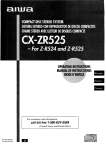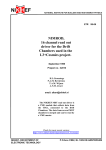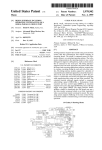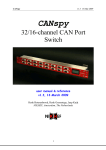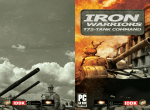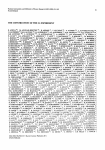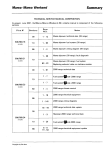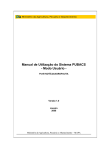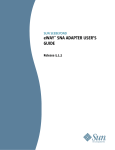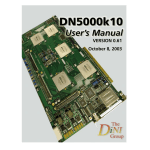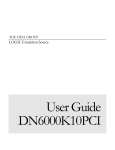Download CPC user manual
Transcript
Check for most recent version: http://www.nikhef.nl/pub/departments/et/L3/cosmics NIK HEF NATIONAL INSTITUTE FOR NUCLEAR AND HIGH ENERGY PHYSICS ETR 99-02 version: March 1999 CPC (Cosmics Personality Card) for the L3+Cosmics experiment. The CPC replaces the MPC in L3, which is the interface of the muon chambers signals to the muon trigger. The CPC splits the signals from the discriminators in the muon system in L3. The old functionality of the MPC is copied into new devices and interfaces to the existing trigger system. Majority logic is added for a new trigger system for L3+Cosmics and TDCs measure the relative timing of muons. A stand alone read-out system in VME is used to read the data independent from the existing L3 data acquisition system. This paper describes CPC version 3. H.L. Groenstege T.A.M. Wijnen P.A.M. Rewiersma J. Stolte email: [email protected] NIKHEF, DEPARTMENT OF ELECTRONIC TECHNOLOGY P.O.box 41882, NL 1009 DB AMSTERDAM CPC March 1999 Contents INTRODUCTION ..................................................................................................................................... 4 ABOUT V3, MODIFIED V2 ......................................................................................................................... 4 MPC FUNCTIONALITY .......................................................................................................................... 6 CPC ............................................................................................................................................................ 7 SIGNAL SPLIT ........................................................................................................................................... 7 MAJORITY LOGIC ..................................................................................................................................... 7 READ OUT CONTROL LOGIC ....................................................................................................................... 8 CARD IDENTIFICATION.............................................................................................................................. 9 JTAG.........................................................................................................................................................10 JTAG CHAINS .........................................................................................................................................11 MASK AND TEST PATTERN ........................................................................................................................12 MAJORITY LOGIC ....................................................................................................................................14 SCINTILLATOR CPC ................................................................................................................................19 READ OUT CONTROL LOGIC ......................................................................................................................23 TDC PROGRAMMING ...............................................................................................................................28 14.1. JTAG instructions .................................................................................................................... 29 14.2. Boundary scan register. ........................................................................................................... 29 14.3. ID code.................................................................................................................................... 30 14.4. Setup registers ......................................................................................................................... 30 14.5. Control registers...................................................................................................................... 32 14.6. Status registers ........................................................................................................................ 32 14.7. Internal test registers............................................................................................................... 32 Figures Figure 1: Signal flow from muon chambers .....................................................................................................4 Figure 2: CPC signal split, mask and test pulse ...............................................................................................7 Figure 3: MACH_PROG, programming port .................................................................................................10 Figure 4: JTAG2, emulated port ....................................................................................................................10 Figure 5: Chain orders and connector names .................................................................................................11 Figure 6: Majority output logic ......................................................................................................................17 Figure 8: JTAG, the TDC chain ....................................................................................................................28 Tables Table 1: MPC registers....................................................................................................................................6 Table 2: MPC Control register.........................................................................................................................6 Table 3: MPC status register............................................................................................................................6 Table 4: MachPro connector ..........................................................................................................................10 Table 5: Mask/ test pattern, Instruction register .............................................................................................12 Table 6 : Testmode select ..............................................................................................................................12 Table 7: Majority logic, Instruction register ...................................................................................................14 Table 8: Majority logic, Set up.......................................................................................................................15 Table 9: Majority logic, Control ....................................................................................................................15 Table 10: Majority logic, input stretcher timing.............................................................................................17 Table 11: Majority output stretcher................................................................................................................18 Table 12: Scintillator, Instruction register......................................................................................................19 Table 13: Scintillator control register ............................................................................................................20 Table 14: Scintillator, stretch and delay.........................................................................................................22 Table 15: Scintillator, test point selector ........................................................................................................22 Table 16: Read Out Control, JTAG register selection.....................................................................................23 Table 17: Read Out Control: Control register ................................................................................................24 Table 18: Read Out Control: Setup register....................................................................................................25 Table 19: Read Out Control, Diagnostics register ..........................................................................................25 page 2 CPC March 1999 Table 20: Read Out Control, Mode register....................................................................................................26 page 3 CPC March 1999 Introduction For the L3+Cosmics experiment the existing L3 muon chambers are used. The signals from the L3 discriminators are used to generate a trigger and to measure their relative timing. A convenient place was found at the back of the existing muon TDC crates. There the MPCs (Muon Personality Cards) connect the FastBus TDCs to the first and second level muon trigger. The signals on the auxiliary connector are a copy of the discriminator signals that come in at the front panel of the TDC cards, converted to TTL signals. The MPCs are replaced by CPCs (Cosmic Personality Cards). On these cards the old (MPC) functionality has been redesigned to occupy less space and consume less power. The added functions are the majority logic needed for the L3+Cosmics trigger and a TDC system for time measurements independently from the existing L3 system. First a prototype (CPC0) was installed to demonstrate that the wire signals can be split to provide the L3+Cosmics system with timing signals from the muon chambers, without disturbing or altering the L3 muon trigger interface. These are now replaced by the final CPC. Figure 1: Signal flow from muon chambers About V3, modified V2 On version 3 (or modified version 2) the quality of the 40 MHz clock, driving the TDCs, is further improved. The buffer that used to be located on a small modification card, mounted on the CPC_V2, is replaced by a RoboClock (Cypess CY7B991). On the modified version 2 this is again a small modification board. On version 3, it is integrated on the CPC itself. Via a register in the majority logic (IC8) it can be checked whether the 40 MHz clock is running (see Table 9). There is a difference here between the modified version 2 and version 3. In version 2 the incoming clock from the front end link is monitored. In version 3 the clock from the RoboClock is monitored. It is possible that the RoboClock still runs at its minimum frequency when the Front End link is absent. This can only be checked by observing the lock error of the TDC or checking the communication via the . front end link. If the CPC powers up without the input clock, the RoboClock is quiet. When the clock is removed during running, its frequency drops to the minimum lock frequency, which is somewhere between 10 and 20 MHz (guaranteed minimum frequency is 20 MHz). page 4 CPC March 1999 New test pulse functions have been implemented. This is in V3, as well in the modified V2. The external testpulse, running on the JTAG cable, is now also available on the Read Out Controller (IC7). And there is a connection, running from the ROC (Read Out Controller) to the Control-Mach (IC3). This makes it possible to generate test pulses to the TDCs and majority inputs from the ROC. From the external testpulse, the ROC can generate a trigger to the TDCs with a fixed delay in respect of the TDC’s input pulses. The feature is added for testing purposes. This test pulse must be enabled in the Control-Mach (see Table 5, control register). Though the definition of the control register has changed, it is compatible with older routines, choosing between the previously existing test pulse sources. Modified V2 cards can easily be recognized by the copy of the serial number on the back side of the RJ45 connector and the yellow connect LED, which used to be red. The serial numbers of V2 range from x011 until x04c and the serial numbers for V3 start at x051. page 5 CPC March 1999 MPC functionality The MPC is described in the paper “The L3 muon trigger interface”[1]. Since the functionality is extended in the case of the CPC, it is described here briefly. The MPC functions can be reached via the LeCroy FastBus TDC. Nine secondary addresses are used to reach the data registers and status/ control address. For the CPC a new address is implemented (C,3). Reading this location will return the card’s fixed address used in the addressable JTAG chain (10 bits). This is the same as the card’s serial number. The identification register can be used to store a 6 bit position identification via FastBus into the CPC. This will be further described in the JTAG description. Address C,2 C,3 C,8...C,B data registers Read Status Card address MPC registers C,C...C,F ORed inputs MPC Write Control Identification Add pattern to MPC registers Replace pattern MPC registers (C,2 is shorthand for address C0000002) Table 1: MPC registers A flip-flop on the MPC determines whether the card is controlled by the PCC (Personality Card Controller) or from FastBus through the LeCroy TDC. The PCC overrides operations from FastBus. When the PCC is master, the data registers cannot be accessed and an SS6 response is returned. The 48 bit data register is split in 4 parts of 12 bits, due to limitations on the auxiliary FastBus connector. data 4 5 8 9 C D control (write C,2) Enable collect Disable collect Set all registers Reset all registers TDC becomes master let PCC be master Bit 0 1 2 3 Status (read C,2) PCC is reading the MPC PCC is master of MPC Collect enabled Power failure on daisy chain circuit Table 3: MPC status register Table 2: MPC Control register The enable/ disable collect commands set and reset a flip flop on the MPC. When this flip flop is set, the 48 registers collect and store pulses from the inputs in the same way as the registers are used by the PCC to collect wire signals. When the PCC becomes master, the flip flop is reset automatically. Only when the TDC is master of the MPC, the data registers can be accessed and the collect flip flop can be controlled. The TDC cannot become master of the MPC when the PCC accesses the MPC at that moment. 1 The muon trigger interface for L3: MPC, PAC, PCC-P, PCC-Z, PCS and PCT, september 1989, H. Groenstege NIKHEF-ET. page 6 CPC March 1999 CPC Signal Split The signal split to the added functionality (majority logic and new TDCs2) is implemented in the same devices that contain the MPC functionality. This strongly reduces the pin count on the board. The old functionality has not been changed. The MACH 466 devices also contain two sets of registers. One set of 96 bits is used to disable noisy channels (only for the new functionality) . The other set of 96 bits is used to inject test patterns upon reception of a test pulse. Figure 2: CPC signal split, mask and test pulse The two set of registers are configured to behave as a JTAG port, which is controlled by a MACH 231 device. The bits are shifted with LSB (Least Significant Bit) first. Upon powerup, the registers are initialized automatically. All wire signals are enabled to the output and the test pattern is reset. However, this cannot be guaranteed, since it requires the power supply to rise monotonously. A power failure can be detected by checking a bit in the Majority Logic, see page 15 (Majority logic, Control). Majority logic IC 8 contains the majority logic. It can run in two modes: • The 96 inputs are compared with a single threshold. • The 96 inputs are divided in an upper and a lower half (48 inputs each). An input signal, longer then app. 15 ns, is recorded. All signals are stretched to app. 1.2 µs. Every 200 ns the total number of hits is determined. This number is compared to the programmable threshold and may thus generate a hit. This hit signal belongs to one of the 2 A 32 channel general purpose Time to Digital Converter, J. Christiansen CERN/ECP-MIC. page 7 CPC March 1999 three muon chamber layers; MI, MM or MO. A register setting determines which output has to be activated. This output is a differential implementation of an open collector output. In this way all CPCs in a crate can pull this line. This line then runs to the CTT (Cosmic Trigger and Timing) module, where the Cosmic trigger is generated. In every P-crate there is one location where signals from two different muon chamber layers are connected to one FastBus TDC. In that case the majority logic works in the splitted mode, with two times 48 channels. Two output signals are generated in the same way as described above and can be routed (software controlled) to the MI, MM and MO outputs. The majority logic chip (IC 8) receives the 40 MHz clock from the read out chip (IC 7). This clock is divided internally to create the clock for the pulse stretchers and other pipe line registers. This divider can be programmed to divide from 7 to 10.5 in eight steps. The setting is done via JTAG. The pipe line clock periods thus vary from 175 to 263 ns, in 12.5 ns steps. The pulse stretchers are active for seven of these cycles. So the one shots run for 1050 to 1575 ns, plus one clock period. The input signal is first stored in a register. On the next clock cycle the one shot starts. This covers the maximum drift time plus one clock cycle for the synchronization uncertainty. Also one clock cycle overlap is needed to determine the total of active one shots. The drift time range is then 1050 to 1575 ns. For information how to set the stretchers see page 14. The reset signal from the FELink can be used to synchronize the clock dividers on the different CPCs. For the scintillators the chip that normally contains the majority logic (IC 8) has an other contents. It logically ORs every eight inputs, which results in 12 signals. These signals can be used by three outputs to form larger ORs. These three outputs are first stretched and then delayed. The stretcher is a retriggerable one-shot that is fired by the rising edge of the OR signal. The delay is made by means of a shift register. For the settings see Table 14: Scintillator, stretch and delay. Read out control logic The CPC Read Out Controller (ROC) in IC7 receives the clock (40 MHz) and control signal (Reset/Trigger) from the NIMROD. The control signal encodes the Reset and Trigger signals using a 3 bit pulse width scheme. Holding the control line high for one clock cycle, followed by a low level for at least two clock cycles encodes the Trigger signal. Holding the control line at high level for three consecutive cycles encodes the Reset signal. The Reset and Trigger signals are distributed to the TDC chips and the Majority logic chip. The Reset signal clears all internal counters and the data memory in the TDC chips. The Trigger signal is used by the ROC to initiate the read out of the TDC chips. The data from the TDC's is read out using a token ring scheme and the data is formatted by adding some identification bits, serialized and sent to the NIMROD via the Front End Link. Data is transferred via two pairs of Low Voltage Differential Signal (LVDS) drivers using the DataStrobe (DS) protocol. The bit rate is 40 Mbit/s and each data word is composed of a start bit, 32 data bits, a parity bit and one stop bit. This results in a maximum data rate of approximately 1 Mword/s. Provisions have been made to be able to read out the Majority Logic as another node in the token ring. This would allow the Majority Logic to send one word of information into the data stream after a Trigger, whenever that becomes useful. page 8 CPC March 1999 Card identification The card address (10 bits) is defined when it is tested after production. This is fixed. The address is the same as its serial number written on the white space. The address is used by the addressable JTAG controller to uniquely address a single card. When two cards in the FastBus crate are swapped, this cannot be detected via the addressable JTAG branch. Two provisions are implemented to deal with the problem: • Using a geographical read cycle in FastBus, the card’s serial number can be read. This serial number is used as an address in addressable JTAG operations. See the MPC register description on page 6 (Table 1: MPC registers). • Using a geographical write cycle in FastBus, an identifier can be written into C,3. It is useful to write the card location inside the FastBus crate into this register. The stored value can be read back via the addressable JTAG chain. See the FastBus control register description on page 6 and the JTAG register description on page 12 (Table 5: Mask/ test pattern, Instruction register). Both methods require access to the L3 FastBus TDCs. page 9 CPC March 1999 JTAG The CPC contains three JTAG ports. These are used for programming some of the devices, testing the printed circuit board and for the settings needed at run time. Some JTAG ports are the standard JTAG ports of the devices, others are created by programming the devices. The pins on the dual row connectors are wired according to the MACH-PRO convention. The Vcc pin is connected to the 5 V supply of the CPC, via a 100 Ω resistor (4.7 Ω in case of the BST port). The TRST (Test bus Reset) is only used on the settings port. The optional program enable pins on the MACH devices are not used. Pin 1 2 3 4 5 Signal TCK NC TMS GND TDI Pin 6 7 8 9 10 signal Vcc TDO GND TRST NC Table 4: MachPro connector Port MACH_PROG is used to program the MACH devices that emulate the MPC functionality and the signal split. This program is stored in EEProm inside the devices. It is non-volatile, but it can be altered. IC 1 and IC 2 (MACH 466 Figure 3: MACH_PROG, programming port devices) contain the same program. IC 3 is the controller of ICs 1 and 2 for the old MPC functionality, for the emulated JTAG chain and for several other functions. To program the devices, the MACH-PRO software (version 1.40f or later) is used. The programs stored in IC1, 2 and 3 together create a second JTAG port on IC3, which is used to load the disable and test pattern registers, for example. These registers are shifted with LSB first. Figure 4: JTAG2, emulated port page 10 CPC March 1999 JTAG chains The mask and test pattern registers and the majority logic and read-out chips contain emulated JTAG ports. Together with the TDCs they are connected to the addressable JTAG port (Ajtag) that will be used to do the various settings on the card. The addressable JTAG ports of all CPCs in one FastBus crate are connected to a JTAG controller, located in a VME crate. For testing, the addressable part can be bypassed, by connecting a JTAG cable to the port Settings. Below the JTAG chain order and connector names on the CPC are given. Figure 5: Chain orders and connector names The BST (Boundary Scan Test) chain can be used to test the card electrically. In this case a test set-up exists for the MPC functionality. Nearly all other functionality can be tested via the Settings chain. The EProm holds the files used to define the functionality of the Altera 10k20 chips, IC 7 and IC 8. These files are automatically loaded at power-up. The EProm is a OTP (One Time Programmable) version. The order of the programming files is first the majority logic and second the Read out controller functionality. The BST chain can be used to reprogram the Altera devices. The programming routine of the Altera software can be used without the hardware protection key. It requires a byte blaster download cable, connected to the parallel port of PC. Because the JTAG chain runs in the other direction, compared to the passive serial load chain (from the EProm), a valid program must reside in EProm to be able to use the byte blaster. page 11 CPC March 1999 Mask and test pattern The combined functionality of ICs 1, 2 and 3, besides creating the MPC functionality, is to split the incoming signals to the TDCs and majority logic. They contain mask and test registers. These are loaded via JTAG. IR 0000 0001 0010 0011 Others Instruction Test pattern Mask register Control register FastBus ID register Bypass Bits 96 96 4 6 1 R/W R/W R/W R/W R R Default 0…0 0…0 0000 00 0000 0 Table 5: Mask/ test pattern, Instruction register Test pattern (IR=0000) After loading the test pattern, test pulses can be generated in the Pause_DR state or the Run-Test/Idle state of the TAP controller. Efficient tests (a walking bit, for example) can be performed, by turning from Pause_DR back to Shift_Dr, instead of loading a complete new 96 bit pattern. This is possible, since the test pattern register does not have a shadow register. One does not have to pass trough the Update_DR state to activate the pattern. Usually the Run Test/Idle state is used to generate test pulses. For both states TMS is kept zero to remain in the state. If the state is just passed, to go to another state (respectively Exit2_DR and Select_DR_Scan), no test pulses are isued. The source and the length of the pulses are determined by the contents of the control register. Mask pattern (IR=0001) Via this register noisy or unused channels can be disabled. Loading a one means disable this channel for the TDCs and the majority logic. Control register (IR=0010) The control register contains four bits. Bit 2…0 Test pulse 000 No test pulse X01 Test pulse from TCK X10 Test pulse from EXT (JTAG) X11 Test pulse from ROC 100 Test pulse from instruction Note *1 *2 *2 *2 *3 Table 6 : Testmode select *1: Power up state. *2: The TAP controller must be in state Run-Test/Idle for test pulse generation. *3: Writing X100 in the control register will generate a test pulse in the TAP controller state Update_DR. Bit 2 is automatically reset in the next state of the TAP controller. Bit 3: Disable test pulse cut. When set, the on board test pulses, initiated by one of the test pulse sources, have the same length as the input pulses. At power up, the bit is reset. In that case the test pulse width is limited to app. 125 ns. page 12 CPC March 1999 FastBus ID (IR=0011) The FastBus ID register is a 6 bit read only register. It is used to verify the geographical location of the CPC, see page 9 for the description. IR=’others’ When loading an other pattern then those described here, the function is Bypass. This is mandatory for IR=1111. The Bypass Register is one bit long. page 13 CPC March 1999 Majority logic IC 8 contains the majority logic. It is set up via JTAG. It can run in two modes: • The 96 inputs are compared with a single threshold. • The 96 inputs are divided in an upper and a lower half (48 inputs each). Each half has its own threshold register. The instruction register is four bits long. IR Register R/W PU 0000 Threshold 0 R/W 0111 1111 0001 Threshold 1 R/W 0011 1111 0010 Set_up R/W 0000 1111 0011 Control/ Status R/W 0000 1X00 0100 Version R 1000 0010 0101 Stretcher R/W 0000 0011 Others Bypass R 0 PU describes the power up situation. This can also be forced by the reset bit in the control register. Table 7: Majority logic, Instruction register All registers are 8 bits long, except for the bypass register, which is one bit long. Threshold register 0 (IR=0000) Threshold register 0 contains the threshold (7 bits) for the lower half of the inputs or the full 96 inputs. It is a read/ write register. During a write, bit 7 is ignored. When read back, bit 7 is 0. Threshold register 1 (IR=0001) Threshold register 1 contains the threshold (6 bits) for the upper half of the inputs. It is a read/ write register. During a write, bits 6 and 7 are ignored. When read back, bits 6 and 7 are 0. page 14 CPC March 1999 Set up register (IR=0010) The set up register determines which outputs are driven when the total number of hits exceeds the threshold. Bit 4 determines whether there are one or two outputs. At power up the bit is reset. In that case there is one output. Bits 1 and 0 determine lower half (or total) output selection. Bits 3 and 2 determine the upper half output selection. When the bit pairs are 11, no output is selected. Bits PU 1:0 11 3:2 11 4 0 7:5 000 Value 00 01 10 11 00 01 10 11 0 1 Result Hit0 to MI Hit0 to MM Hit0 to MO No output Hit1 to MI Hit1 to MM Hit1 to MO No output 96 inputs 2*48 inputs Comment Hit0 is the result from the total or the lower half. Hit1 is the result from the upper half. See also page 7. Not used PU describes the power up situation. This can also be forced by the reset bit in the control register. Table 8: Majority logic, Set up The settings can be read back. Bits 7, 6 and 5 are zero. When the bit 4 is one and for both halves the same output is selected, the two hit results are logically ORed. Control/ Status register (IR=0011) Bit PU Description 0 0 Hit 0 Register 1 0 Hit 1 Register 2 X Clock running 3 1 Power up reset monitor 4 0 (Differential mode) 5 0 Enable drivers 6 1 Enable synchronization 7 0 Simulate power up PU: Power Up situation Table 9: Majority logic, Control The hit 0 register (bit 0) in the control/ status register monitors whether the output of lower half (or the total number of channels) of the majority logic has seen a hit. A hit means that the number of active channels within the maximum drift time period has exceeded the programmed threshold. The bit is reset when read (destructive read). Bit 1 does the same for the upper half. page 15 CPC March 1999 Bit 2 monitors the 40 MHz clock. It is reset when the TAP controller passes the Runtest/Idle state. It is set by clocking a one by means of the 40 MHz clock, during the time the TAP controller moves to Capture_DR. There is a difference here between the modified version 2 and version 3. In version 2 the incoming clock from the Front End link is monitored. In version 3 the clock from the RoboClock is monitored. It is possible that the RoboClock still runs at its minimum frequency when the Front End link is absent. This can only be checked by observing the lock error of the TDC or checking the communication via the . front end link. If the CPC powers up without the input clock, the RoboClock is quiet. When the clock is removed during running, its frequency drops to the minimum lock frequency, which is somewhere between 10 and 20 MHz (guaranteed minimum frequency is 20 MHz). Bit 3 registers a (hardware) power up reset. This signal is generated by a voltage monitor chip connected to the supply voltage of the board. The bit is reset when read (destructive read) Bit 4 is not used. Bit 5 is the output enable of the three majority output drivers. Bit 6 enables synchronization of the one-shots in the majority logic. The reset signal from the FELink is passed to the majority logic, via the read out chip. The front edge of the reset signal is used to synchronize the pipe line clock. If the reset signal is longer then two clock periods (of 25 ns), the majority output drivers are disabled until the reset drops again. Register bit 7 is used to simulate a power up reset. It must be set to one and than reset again. It does not affect the TAP controller. The other bits in the register and other registers are set to the power up situation. Version register (IR=0100) The Version register is used to identify the version of the programmed functionality. It is a read only register. For the version described here it reads 1000 0010. page 16 CPC March 1999 Stretcher register (IR=0101) The Stretcher register determines the speed of the one shots. Since the input pulses have to be synchronized with the digital one_shot’s clock, the total length must be the drift time plus one clock cycle. The clock for the one_shots is derived from the 40 MHz clock, coming from the NIMROD. This clock is divided to obtain the pipe line clock. Six clock cycles from the divider are used for the drift time by the one shot and one more for the synchronization uncertainty. For the L3 muon chambers the drift time is app. 1.2 µs. Bit 2:0 ÷N 000 7 001 7.5 010 8 011 * 8.5 100 9 101 9.5 110 10 111 10.5 *: Power up setting. Pipe Clock [ns] 175 188 200 213 225 238 250 263 Drift Time [ns] 1050 1125 1200 1275 1350 1425 1500 1575 Stretch Time [ns] 1225 1313 1400 1488 1575 1663 1750 1838 Table 10: Majority logic, input stretcher timing The halves in the table are created by alternating dividing by N and N+1. The stretch time is the maximum drift time plus the input synchronization time. This is the time that the one-shot runs. Bit 3 disables the time over threshold output. Comparators in the majority logic check whether the amount over one-shots running is more then specified in the threshold register. This is done every pipe-line clock. Thus the output of the comparator is time over threshold. The rising edge of this signal starts a one-shot. The one-shot then runs for a period specified in bits 7 to 4. When a new rising edge of the time over threshold is detected while the oneshot is already running, the one-shot is restarted. So it is a retriggerable one-shot. Restarting does not introduce gaps in the output signal. The output of this one-shot is logically ORred with the time over threshold signal and forms the majority output towards the CTT. Setting bit 3 disables the ORing of the time over threshold. In that case only the one-shot output is seen at the output. At power up, bit 3 is reset. Figure 6: Majority output logic page 17 CPC ns bits 2:0 (Pipeline clock, see Table 10) Bits 000 001 010 011* 7:4 175 188 200 213 175 188 200 213 0000 175 188 200 213 0001 350 376 400 426 0010 525 564 600 639 0011 700 752 800 852 0100 875 940 1000 1065 0101 1050 1128 1200 1278 0110 1225 1316 1400 1491* 0111* 1400 1504 1600 1704 1000 1575 1692 1800 1917 1001 1750 1880 2000 2130 1010 1925 2068 2200 2343 1011 2100 2256 2400 2556 1100 2275 2444 2600 2769 1101 2450 2632 2800 2982 1110 2625 2820 3000 3195 1111 *: Power up setting *: Power up setting March 1999 100 225 225 225 450 675 900 1125 1350 1575 1800 2025 2250 2475 2700 2925 3150 3375 101 238 238 238 476 714 952 1190 1428 1666 1904 2142 2380 2618 2856 3094 3332 3570 110 250 250 250 500 750 1000 1250 1500 1750 2000 2250 2500 2750 3000 3250 3500 3750 111 263 263 263 526 789 1052 1315 1578 1841 2104 2367 2630 2893 3156 3419 3682 3945 The minimum pulse width of the majority output signals is one pipeline clock cycle. Table 11: Majority output stretcher IR=’others’ When loading an other pattern in the Instruction Register then those described here, the function is Bypass. This mandatory for IR=1111. The Bypass Register is one bit long. page 18 CPC March 1999 Scintillator CPC The programming of IC 8 is different for the scintillator CPC, used in the auxiliary box. The chip that normally contains the majority logic (IC 8) has an other contents. It logically ORs every eight inputs, which results in 12 signals. These signals can be used by three outputs to form larger ORs. These three outputs are first stretched and then delayed. The stretcher is a retriggerable one-shot that is fired by the rising edge of the OR signal. The delay is made by means of a shift register. Also IC 1, 2 and 3 behave different. The FastBus interface is removed and the FB_ID will always return 00 0000 via Jtag. The 96 inputs are positive inputs for this version, instead of active low as needed for the interface to the LeCroy TDC. The mask and test pattern act the same as in the normal CPC. Figure 7: IC 8 for scintillator CPC IR Register R/W PU 0000 Select pattern 1 R/W 0000 0000 0000 0001 Select pattern 2 R/W 0000 0000 0000 0010 Select pattern 3 R/W 0000 0000 0000 0011 Control/ Status R/W 0100 0111 X000 0100 Version register R 1100 0000 0010 0101 Clock divider R/W 0000 0000 0011 0110 Stretch register R/W 1001 1001 1001 0111 Delay register R/W 0110 0110 0110 1000 Test point register R/W 0000 0111 1111 PU describes the power up situation. This can also be forced by the reset bit in the control register. Table 12: Scintillator, Instruction register page 19 CPC March 1999 Select pattern (IR=0000, 0001, 0010) Every eight inputs are logically ORred. For the three outputs, these patterns determine which of these twelve groups are used to create the complete OR. The select pattern is numbered 1 to 3, according to the octant numbers. On the board and in the schematics, outputs 0, 1 and 2 are called MI, MM and MO respectively. Control/ status register (IR=0011) The control/ status register Bit PU Description 0 0 Hit register 1 1 0 Hit register 2 2 0 Hit register 3 3 X Clock running 4 1 Differential mode 5 1 Enable output drivers 6 1 Enable synchronization 7 0 NoOR 8,9 00 Not used 10 1 Power up reset monitor 11 0 Simulate power up PU: Power Up situation Table 13: Scintillator control register Bit 0, 1 and 2 register whether one of the outputs has seen a hit. The bits are reset when read (destructive read). Bit 3 monitors the 40 MHz clock. It is reset when the TAP controller passes the Runtest/Idle state. It is set by clocking a one by means of the 40 MHz clock, during the time the TAP controller moves to Capture_DR. There is a difference here between the modified version 2 and version 3. In version 2 the incoming clock from the Front End link is monitored. In version 3 the clock from the RoboClock is monitored. It is possible that the RoboClock still runs at its minimum frequency when the Front End link is absent. This can only be checked by observing the lock error of the TDC or checking the communication via the . front end link. If the CPC powers up without the input clock, the RoboClock is quiet. When the clock is removed during running, its frequency drops to the minimum lock frequency, which is somewhere between 10 and 20 MHz (guaranteed minimum frequency is 20 MHz). Bit 4 controls the mode of operation of the output drivers. The outputs are truly differential or the differential implementation of an open collector output. For the scintillator CPC it should be set (power up, default situation). Bit 5 is the output enable of the three output drivers. For the scintillator CPC the bit is set during power up. Bit 6 enables synchronization of the clock divider. The reset signal from the FELink is passed to the stretcher logic, via the read out chip. The front edge of the reset signal is used to synchronize the pipe line clock. If the reset signal is longer then two clock periods (of 25 ns), the output drivers are disabled until the reset drops again. page 20 CPC March 1999 Bit 7 disables the logical ORing of the original input signal with the output of the one-shot. Bits 8 and 9 are not used. Bit 10 registers a (hardware) power up reset. This signal is generated by a voltage monitor chip connected to the supply voltage of the board. The bit is reset when read (destructive read). Bit 11 is used to simulate a power up reset. It must be set to one and than reset again. It does not affect the TAP controller. The other bits in the register and the other registers are set to the power up situation. Version register (IR=0100) The version register is used to identify the version of the programmed functionality. It is a read only register. For the version described here it reads 1100 0000 0010. Version 1100 0000 0001 does not contain the test point selector. Clock speed (IR=0101) The pipe line clock speed is determined by three bits. It works the same as for the majority logic. For the definition see Table 10: Majority logic, input stretcher timing. Stretch register (IR=0110) The output stretch register determines the length of the output pulse in pipe line clock cycle units. The minimum is one clock cycle. The maximum is 15 clock cycles. The values for the three outputs can be set to different values. See the table below. page 21 CPC March 1999 Delay register (IR=0111) The delay register determines the length of the output pulse in pipe line clock cycle units. The minimum is one clock cycle. The maximum is 15 clock cycles. One more clock cycle is used in the pipe line structure. The values for the three outputs can be set to different values. Output Bits default Stretch Delay Bit groups for stretch and delay registers 3 2 1 11:8 7:4 3:0 1001 1001 1001 0110 0110 0110 Table 14: Scintillator, stretch and delay Use Table 11 to determine the values in ns. Test point register (IR=1000) The test point register selects one of the 96 inputs to be routed to pin 7 of connector Diag8 on the CPC. Write XXXX XSSS SSSS Test point register Read 0000 0SSS SSSS Power up 0000 0111 1111 Table 15: Scintillator, test point selector Valid range for input selection is 0 to 95. If a higher value is written (96…127), the output is zero. Please note that the input is taken after the mask and test pattern section of the CPC. Diagnostics connector Diagnostics connector Diag 8 carries the following signals: Pin Name Use 1 Vcc +5 V 2 Clk_div Divided clock used by IC 8 3 Dia8p9 In CPC V2 used to connect to IC 7 4, 5, 6 TPM4, 3, 2 Not used 7 TPM1 Test point output, see test point register 8 _PUR Power up reset monitor of IC 8 only 9…12 TPM7, 8, 5, 6 Not used 13 _A_Hit Stretched hit signal 14, 15, 16 MO_D, MM_D, MI_D Logic one / active in scintillator CPC 17, 18, 19 MO_E, MM_E, MI_E Majority outputs / logic one in scintillator CPC 20 Gnd 0V page 22 CPC March 1999 Read out control logic The chip IC 7 contains the Read Out Control logic (ROC). It is set up via JTAG and the clock, trigger and reset signals are handled to acquire and send out the TDC data via the Front End Link. Front End Link The clock, trigger and reset signals are sent from the Cosmic Trigger and Timing unit to the CPC cards via the Front End Link cable (standard FTP-type cable with RJ45 connectors) using differential LVDS drivers and receivers. The clock is transmitted via one pair of wires, the other signals are time-encoded over one other pair of wires. The encoder uses three consecutive cycles of the 40 MHz clock and uniquely defines the four signals as follows: t1 0 1 1 1 1 t2 0 0 1 0 1 t3 0 0 0 1 1 Description no operation Trigger bunch count reset: resets only the TDCs event count reset: reset the ROC and the TDCs global reset: resets the ROC and the TDCs Data format The data format that the ROC generates is described in a separate document called “The L3 + Cosmics Data Format” by T. Wijnen, B. Petersen and C. Timmermans. JTAG The JTAG instruction register is four bits long and it is used to select one of the internal data registers. IR 0000 0001 0010 0011 0100 0101 0110 0111 1111 Others Register User identity Control Setup Version Diagnostics DAC Mode Rand Bypass Bypass Mode R/W R/W R/W R R R/W R/W R/W R R Default 1111 1111 1100 0000 0010 0000 1000 0110 0000 0000 1000 0000 0000 0000 0000 0000 0 0 Table 16: Read Out Control, JTAG register selection page 23 CPC March 1999 All data registers are 8 bits long, except for the Bypass Register, which is one bit long. The default value is the contents of the data registers at power up. User Identity Register (IR=0000) The eight bits User Identity register is used to identify the card when read out via the front end link (FELink). It can be filled with e.g. the crate number and card position. In the current version (dated 12-Mar-1999) this information can not be read out via the FELink! Control Register (IR=0001) The Control register is used to control the functions of the ROC. The contents of the register may only be changed when the trigger system is disabled, because otherwise the ROC functions could be altered or aborted while it is processing data. The individual bits have the following meaning: Bit 0 1 2 3 4 Function CR0 CR1 EnTTrigger EnMTrigger EnETrigger Default 0 0 0 0 0 5 EnART 0 6 7 Inhibit FE Link Inhibit ROC 1 1 Description Clock speed select for ROC test pulse Clock speed select for ROC test pulse Enable ROC test pulse trigger Enable "internal" Majority Trigger signal Enable external Trigger and Reset signal from test connector Enable the artificial Reset/Trigger signals ( these are generated via EnTTrigger, EnETrigger and EnMTrigger ) Disable Reset/Trigger signals via FELink Disable ROC (holds the Reset signal for the ROC and TDCs Table 17: Read Out Control: Control register After power up the Control register is preset to "1100 0000" and it is thus holding the Reset signal for the ROC chip and the three TDC chips is a steady active state. page 24 CPC March 1999 Setup Register (IR=0010) The Setup register is used to setup the different modes and options in the ROC. The contents of this register may be altered only when the trigger system is paused, because any change causes the token ring read out scheme to be altered immediately. The individual bits have the following meaning: Bit 0 1 2 3 4 5 6 7 Function EnTDC Unused Unused EnMAJ * Unused EnEOG EnFake EnEcnt Default 1 0 0 0 0 1 0 0 Description Enable the read out of TDCs Enable the read out of the Majority Logic Enable the End Of Group word Enable the fake TDC words Enable the Event Count word Table 18: Read Out Control: Setup register The function bits marked with “*” are not implemented in this version of the ROC chip, dated 12-Mar-1999. Version Register (IR=0011) The Version register is used to identify the version number of the programmed functionality in this chip. It is used to determine which "firmware" is present on this CPC card. This version (12-Mar-1999) of the ROC will identify itself with a value of "1000 0110". At power up this value is loaded from the configuration PROM. Diagnostics Register (IR=0100) The Diagnostics register allows to user to check on various internal signals of the ROC chip to verify that it is functioning properly. It may also provide a means to diagnose problems. After power up all bits are zero but they may turn on at any time. In the current version of the ROC, the individual bits have the following meaning: Bit Signal Default Description 0 Active 0 a TDC or an internal register is active (i.e. it has the token and is sending data 1 DataReady 0 a TDC or an internal register has set the Data Ready signal 2 TokenAway 0 the ROC has sent out the token to the TDCs 3 TdcAct 0 the OR of the TDC Active signals 4 TdcErr 0 the OR of the TDC Error signals 5 GetData 0 the ROC is asking for data from a TDC or an internal register 6 SerBusy 0 the data serializer is busy sending a word via the FELink (Data/Strobe output lines) 7 SendEvent 0 the ROC received a trigger and is sending out data belonging to this event Table 19: Read Out Control, Diagnostics register page 25 CPC March 1999 This register is primarily intended to be used by experts only. The register is read only and does not require to be initialized via the JTAG port. The signals that are attached to the individual bits, may vary between different versions of the ROC (see also diagnostics connector). DAC Register (IR=0101) The DAC register drives the Digital-Analog-Converter chip on the Datimizer card (this is a front-end board for a wire chamber). This register has no use on the CPC card, but it is kept here for compatibility. Bits 7…0 Function DAC Default 0000 0000 Description Threshold value for discriminators Mode Register (IR=0110) The DAC register drives the Digital-Analog-Converter chip on the Datimizer card (this is a front-end board for a wire chamber). This register has no use on the CPC card, but it is kept here for compatibility. Bit 0 1 2 3 4 5 6 7 Signal ART0 ART1 ART2 TS3 TS4 TS5 Spare6 Spare7 Default 0 0 0 0 0 0 0 0 Description Artificial Reset/Trigger selector " " test output on connector roc_ts pin 3 test input on connector roc_ts pin 4 test input on connector roc_ts pin 5 Spare Spare Table 20: Read Out Control, Mode register The encoding of the ART (artificial reset and trigger) bits is as follows: ART2 0 0 0 0 1 1 ART1 0 0 1 1 0 1 Others ART0 0 1 0 1 0 1 Description no operation Trigger bunch count reset: resets only the TDCs event count reset: reset ROC and the TDCs global reset: resets ROC and the TDCs emulate power up reset inside ROC no operation RAND Register (IR=0111) The RAND register provides a way to set a seed for the internal 9 bit random number generator. The generated number is used as a word count for the fake TDC word unit. When the EnFake bit in the Setup register is set, a random number of fake TDC words is inserted page 26 CPC March 1999 into the data stream that is sent out via the FELink. The fake TDC word is formatted as "33xxxxxx", where the lower 24 bits are filled with a rotating bit pattern. Bits 7…0 Function RAND Default 0000 0000 Description Seed for random number generator Bit 7 and 6 of the seed are AND-ed with the generated random number to form the fake word count for one event, in order to limit the maximum word count. So the maximum word count will either be 63, 127, 191 or 255. Each trigger will get the next number from the pseudo random number generator. Bypass Register (IR=1111 or IR=’others’) When loading a different pattern than those described above into the instruction register, the function is Bypass. This is also mandatory for IR=1111. The bypass register is one bit long and its data is always “0”. Diagnostics connector There is a diagnostics connector on the CPC card where one can monitor several signals of the ROC chip. pin 1 2 3 4 5 6 7 8 9 10 11 12 Signal Vcc ClkA Trigger GetDataIn DataReady CTrigger CTokenOut CTokenIn ROReset PowerUp SEvent Diag bit 7 13 SerBusy 6 14 GetData 5 15 16 17 18 TdcErr TdcAct TokenAway DataReady 4 3 2 1 19 Active 0 20 Gnd - Description Vcc (+ 5 Volt). not connected the clock signal of the ROC the trigger signal of the ROC and TDCs the internal GetData signal (for bog/eog) the internal DataReady signal ( " ) the internal Trigger signal the token signal sent out to the TDCs the token signal coming from the TDCs the internal ROC Reset signal the internal PowerUp signal (active low) the ROC received a trigger and is sending out data belonging to this event the data serializer is busy sending one word via the FELink (Data/Strobe output lines) the ROC is asking for data from a TDC or an internal register the OR of the TDC Error signals the OR of the TDC Active signals the ROC has sent out the token to the TDCs a TDC or an internal register has set the Data Ready signal a TDC or an internal register is active (i.e. it has the token and is preparing data for readout Ground (0 Volt) page 27 CPC March 1999 TDC programming The Ajtag or Settings JTAG port connects to the TDC chips according the order shown in Figure 8. See Figure 5 for the location in the total chain. It is used to load the settings of the TDC chips and check their status. The TDC’s JTAG ports are in accordance with the IEEE 1149.1 standard. Figure 8: JTAG, the TDC chain The text and tables below are copied from 3 Christiansen’s TDC description [ ] version 0.4, chapter 14. For the most recent information one should use the TDC’s manual. JTAG Test and Programming Port. A JTAG (Joint Test Action Group, IEEE 1149.1 standard [3,4] port is used to program the programmable features in the TDC, and also to get access to test facilities built into the TDC. The JTAG protocol is today an accepted standard for chip and module testing, and easy to use debugging tools are available on PCs. Full boundary scan is supported to be capable of performing extensive testing of TDC modules while located in the system. Testing the functionality of the chip itself is also supported by the JTAG INTEST capability. In addition special JTAG registers have been included in the data path of the chip to be capable of performing effective testing of all the timing registers and embedded memory structures. Programming of the device is separated into two scan path groups. The setup group consists of setups which can not be changed while the system is actively running (trigger window, looking back window, enable of trigger matching, etc.) and a control group which can be changed during a run (enable and disable of noisy channels). To save silicon area for the large shift registers for the programming data they are not made with two sets of JTAG registers (shift register and update register). This has the inconvenience that if the programming data are read via JTAG (only used during functional testing of devices) one of the programming bits will be lost and the bit sequence will be shifted by one. An additional scan path is available to read status information from the TDC while it is running (error flags). 3 A 32 channel general purpose Time to Digital Converter, J. Christiansen CERN/ECP-MIC. page 28 CPC March 1999 14.1. JTAG instructions The JTAG instruction register is 4 bits long and is in full accordance with the IEEE 1149.1 standard. The JTAG controller macro from ES2 does not support being read from JTAG. When passing through the JTAG state CAPTURE-DR the instruction register gets set to 0001 Bin (IDCODE). 0000 0001 0010 0011 0100...0111 1000 1001 1010 1011 1100...1110 1111 EXTEST. Boundary scan for test of inter-chip connections on module. IDCODE. Scan out of chip identification code. SAMPLE. Sample of all chip pins via boundary scan registers. INTEST. Using boundary scan registers to test chip itself. NOT IMPLEMENTED. Setup. Load of setup data. Control. Load of control information. Status. Read of status information. Coretest Access to internal test scan registers. NOT IMPLEMENTED. BYPASS. 14.2. Boundary scan register. All signal pins of the TDC are passed through JTAG boundary scan registers. All JTAG test modes related to the boundary scan registers are supported (EXTEST, INTEST, SAMPLE). BSR# 0 1 6:2 22:7 28:23 29 30 31 32 33 49:34 50 51 52 53 54 87:55 88 Pin name Enable data_ready Enable bus Vernier[4:0] Coarse_out[15:0] Channel[5:0] Rising Active Event_end Data_ready Error Coarse_in[15:0] Chip_select Next_event Get_data Trigger Reset Hit[32:0] Clk Description Enable of data_ready driver (not a direct pin). Enable of read-out bus drivers (not a direct pin). Read-out vernier. Read-out time coarse out. Read-out channel. Read-out rising edge. TDC active in read-out. Read-out event end. Read-out data ready. Programmable error status output. Read-out time coarse in (parallel trigger in). Read-out chip select. Read-out next event. Read-out get data. Trigger in Reset of buffers and counters. Hits. Clock. page 29 CPC March 1999 14.3. ID code A 32 bit chip identification code can be shifted out when selecting the ID shift chain. 0 11: 1 27: 12 31: 28 ES2 code TDC part code Version code Start bit = 1. ES2 manufacturer code = 00001000111. decimal 3500 = binary 0000110110101100 first version = 0000 14.4. Setup registers The JTAG setup scan path is used to load programming data that can not be changed while the TDC is actively running. For testing purposes it is possible to read the status of internal counters via this scan path. 15:0 16 17 18 34:19 35 36 37 45:38 53:46 54 55 56 72:57 78:73 86:79 87 89:88 94:90 95 96 97 98 99 100 101 Yes/no trigger time tag offset[l5:0]. (read back of trigger time tag counter) Enable parallel trigger. *1 Enable sync trigger. *1 Enable serial trigger. *1 Trigger matching window [15:0]. (read back of active trigger) Enable read-out of start measurements. Enable subtraction of trigger time tag. Enable overlapping triggers. Looking back window[7:0] Looking ahead window [7:0] Enable subtraction of start time measurement (channel 32) Enable matching Enable automatic reject Reject offset[15:0]. (read back of reject counter) Adjust_channel[5:0] Adjust[7:0] Enable_individual_adjust Test mode: 00 = normal mode, 01 = Coarse, Vernier, channel, falling from internal test scan path, 10 = Vernier from internal test scan path, 11 = Toggle between internal test scan path and its inverted value. DLL_current_level_b[4:0], charge pump current levels inverted. For normal operation = 11110 bin (minimum current levels). DLL reset Detect falling edge start Detect falling edge odd channels Detect falling edge even channels Detect both edges (all channels) Enable empty start Must be equal to setup bit 54 page 30 CPC March 1999 102 Enable use of double synchronisers. 103 Enable double hit priority queue. 104 Enable start gating 120:105 Coarse count offset[15:0] (read back of coarse count) 121 Enable token read-out mode. 122 Not_locked error mask. 123 Hit_error error mask. 124 Event_buffer_overflow error mask. 125 Trigger_buffer_overflow error mask. 126 Serial_trigger_error error mask. *1: Only one of the three trigger modes can be enabled. 14.4.1.Programming of channel adjustment constants. The programming of the channel adjustment constants are a bit more complicated than the other programmable parameters loaded via the setup scan path. The required 32 eight bit channel adjustment constants are not directly accessible as individual fields of the setup scan path. The 32 channel specific constants are stored in a memory written into via the setup scan path. The adjustment constant for the start channel (or the common adjustment constant) is taken as the last adjustment constant shifted into the setup scan chain (not contained in channel adjustment memory). This approach saves significant silicon area but requires the adjustment constants to be loaded one by one using the serial JTAG protocol. In case only a common adjustment is required the channel adjustment memory can be left non initialized. Loading of one of the channel adjustment constants into the channel adjustment memory is performed as follows. The channel identifier Adjust_channel[5:0] and its corresponding adjustment constant Adjust[7:0] must be loaded into the setup scan path. When the setup data have been loaded, and the JTAG controller gives a update signal (by passing through the JTAG state: UPDATE) to the JTAG registers, the adjustment constant will be written into the memory position pointed to by the channel identifier. The other bit fields of the setup data can be left undefined during the loading of the channel specific adjustment constants. The loading of the common (or start) adjustment constant must be performed as the last loading of the setup scan chain. The channel identifier must in this case be set to Adjust_channel[5:0]=10 0000 bin to signal that this value shall not be written into the adjustment memory, but must remain in the normal JTAG scan register. In addition all the other programming parameters in the setup chain must have all their parameters set as required for the application. 14.4.2. Performing a reset of the DLL. The Delay Locked Loop is not initialized when the reset pin of the TDC chip is asserted. The lock tracing of the DLL is a rather slow process and is only required to be performed once after power has been applied. The normal reset pin of the TDC can be used at regular intervals to initialize all counters and buffers in the TDC without having to wait for the DLL to acquire lock. A reset of the DLL must be performed via the JTAG setup scan path after power up. First a load of the setup registers must be performed with the DLL_reset signal assigned to a logical one and the required charge pump current levels set to their correct value. For this to perform a real reset of the DLL it is required that the JTAG controller issues an update by being passed through the update state of the JTAG port controller [3,4]. To enable the DLL to start lock tracing from its reset state the DLL_reset signal must be released again in the page 31 CPC March 1999 same manner. Now the DLL will start lock tracing and when lock has been obtained the not_locked status bit will be cleared. 14.5. Control registers The JTAG control scan path is used to enable/disable channels which can be done while the TDC is actively running. 32:0 Channel enable [32:0] 14.6. Status registers The JTAG status scan path is used to get access to the error status of the TDC while it is running (or after a run). 0 Not_locked. 1 Hit_error. 2 Event_buffer_overflow. 3 Trigger_buffer_overflow. 4 Serial_trigger_error. 14.7. Internal test registers The JTAG internal test scan path is used to perform extended testing of the TDC chip. The internal scan path gives direct access to the interface between the hit registers and first level buffer logic. It is used in connection with the test mode select bits in the setup scan path. 31:0 Vernier in non encoded form [31:0]. 47:32 Coarse[15:0] 53:48 Channel[5:0] 54 Falling edge 55 Select difference (read only) 56 Select start (read only) 57 Store start (read only) 58 Store event (read only) page 32
































